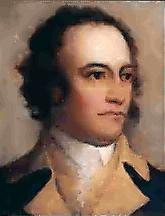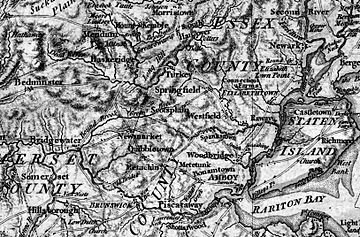Battle of Staten Island facts for kids
Quick facts for kids Battle of Staten Island |
|||||||
|---|---|---|---|---|---|---|---|
| Part of the American Revolutionary War | |||||||
 Battle of Staten Island |
|||||||
|
|||||||
| Belligerents | |||||||
|
|
||||||
| Commanders and leaders | |||||||
|
|
|||||||
| Strength | |||||||
| 1,000 regulars | 900 regulars 400 provincial militia |
||||||
| Casualties and losses | |||||||
| 10 killed 20 wounded 150–259 captured |
5 killed 7 wounded 84 missing |
||||||
The Battle of Staten Island was a surprise attack by American troops during the American Revolutionary War. It happened on August 22, 1777, on Staten Island, New York. Major General John Sullivan led the Continental Army (American) soldiers. Their goal was to raid British forces stationed there.
General Sullivan thought the British on Staten Island were weak. This was because many British soldiers had left New York City. Even though General George Washington wanted Sullivan's troops to join the main army, Sullivan decided to attack Staten Island first. The raid did not go as planned. The Americans faced problems like not having enough boats to escape. One group of soldiers was even led to the wrong place by their guide. Because of these issues, the Americans lost more soldiers than the British. General Sullivan was later investigated, but he was cleared of any wrongdoing.
Contents
Why Did the Battle Happen?
The War Moves South
In 1776, British forces left Boston. General George Washington had set up defenses that threatened them. The British then captured New York City. This forced Washington's army to retreat across New Jersey. Later that year, Washington surprised German troops at Trenton, New Jersey. He then regained control of most of New Jersey.
In July 1777, the British General William Howe and his brother, Admiral Richard Howe, launched a large fleet. This fleet carried most of their army from New York. Their goal was to capture Philadelphia, which was the American capital. The army planned to land in Chesapeake Bay and march north.
Washington's Orders to Sullivan
General Washington quickly learned about the British fleet's departure. However, he did not know where they were going. He first thought they might be heading to Charleston, South Carolina. He even prepared to send troops north to defend the Hudson River. This was against another British army coming from Canada.
But on August 21, Washington found out the British fleet was in Chesapeake Bay. He realized Philadelphia was in danger. He immediately ordered his entire army to move south quickly. He told Major General John Sullivan to join the main army "with all convenient speed."
Sullivan's Plan for Staten Island
Meanwhile, General Sullivan had learned something important. When General Howe's army left, Staten Island became less protected. Sullivan saw this as a chance to attack. He planned a raid against British targets on the island.
He knew that most British regular soldiers were at the north end of the island. But about 700 Loyalist (Americans who supported the British) militia were spread out. They were along the western shore, facing New Jersey. Sullivan's plan was to cross two groups of soldiers onto the island. They would start from Elizabeth, New Jersey. Their goals were to capture Loyalist soldiers and destroy supplies. After the raid, they would return to the mainland using the Old Blazing Star Ferry.
Who Was on Staten Island?
British and Loyalist Forces
The British defenses on Staten Island were led by Brigadier General John Campbell. His forces included about 900 regular soldiers. These were from the British 52nd Foot and German soldiers. The German soldiers were often called "Hessians." They came from the German states of Waldeck and Ansbach. These regular troops were mostly stationed near the northeastern tip of the island.
General Campbell also had about 400 Loyalist militia. These were New Jersey Loyalists known as Skinner's Brigade. They were commanded by Cortlandt Skinner. Skinner's men were placed at small outposts along the western shore.
American Forces
General Sullivan was based in Hanover, New Jersey. On August 20, he told his commanders to get their troops ready. About 1,000 American soldiers were chosen for the mission. Most of these troops came from Sullivan's own division. This included the First and Second Maryland Brigades. Some soldiers from the 2nd Canadian Regiment and a New Jersey militia company also joined.
On the afternoon of August 21, two columns of soldiers left the camp. One column was led by Brigadier General William Smallwood. The other was led by General Sullivan himself, with help from a French officer, the Chevalier Philippe Hubert Preudhomme de Borre. They reached Elizabethtown late that night. After a short rest, they began crossing to Staten Island early the next morning.
One group, led by Colonel Matthias Ogden, crossed near Fresh Kills. They rowed up the kill to approach their target from behind. The rest of the troops crossed near Palmer's run. There, they split into three groups. Smallwood and Sullivan led most of their soldiers to attack specific targets. Each left a regiment behind to protect their escape route.
How the Battle Unfolded
Early Morning Attacks
At dawn, Colonel Ogden attacked the Loyalist outpost of Elisha Lawrence. He surprised them and quickly captured 80 prisoners. Ogden then moved to attack another Loyalist outpost. This one was led by Lieutenant Colonel Edward Vaughan Dongan. Dongan's men fought back strongly, even after Dongan was badly wounded. This forced Ogden to retreat towards the Old Blazing Star Ferry. Ogden decided it was too risky to wait. He crossed his men back to the mainland before Sullivan and Smallwood arrived.
General Sullivan moved to attack another Loyalist group. These were soldiers under Lieutenant Colonel Joseph Barton. But Barton's troops were ready. They ran away when Sullivan's forces came near. Sullivan had placed soldiers to catch anyone trying to escape. However, many of Barton's men still got away. They either crossed to New Jersey or hid in the woods. Sullivan managed to capture 40 prisoners, including Barton. Some of Sullivan's men tried to attack the Loyalist headquarters. But the British forces there were too strong, so the Americans pulled back.
Smallwood's Retreat
General Smallwood's column had a problem. Their guide led them to the front of a Loyalist group instead of their rear. Smallwood ordered the attack anyway. The Loyalists ran at first. But General Skinner quickly rallied them. The situation then turned against the Americans. They had to retreat quickly. However, they did manage to destroy some enemy supplies and capture a battle flag.
The American Retreat
Smallwood and Sullivan met up near Richmond, a village in the middle of Staten Island. They then headed to the Old Blazing Star Ferry. Sullivan called for more boats to speed up their crossing. But the boats never arrived. So, he started crossing his troops and prisoners using the three boats that Ogden had used earlier.
As they were crossing, General Skinner and his men arrived. They were joined by General Campbell's forces, including the 52nd British Regiment and the German Waldeck and Ansbach regiments. Sullivan ordered two companies, led by Majors Stewart and Tillard, to cover the retreat. These about 80 men bravely held off the British forces. They stopped several strong attacks until all the other American troops had crossed to the mainland. Some of these covering soldiers managed to escape. But many were killed, and a large number surrendered. This happened after they ran out of ammunition and the British started firing grape shot at them.
Aftermath
The British reported their losses as 5 killed, 7 wounded, and 84 missing. The British captured between 150 and 259 American soldiers. Among the captured Americans were 21 officers.
After the battle, Sullivan's remaining forces marched south. They were able to join General Washington's army near Philadelphia. They even took part in the important Battle of Brandywine on September 11.
General Sullivan later faced a court martial (a military trial). He was accused of mismanaging the raid in several ways. However, the court found him innocent of all charges.



